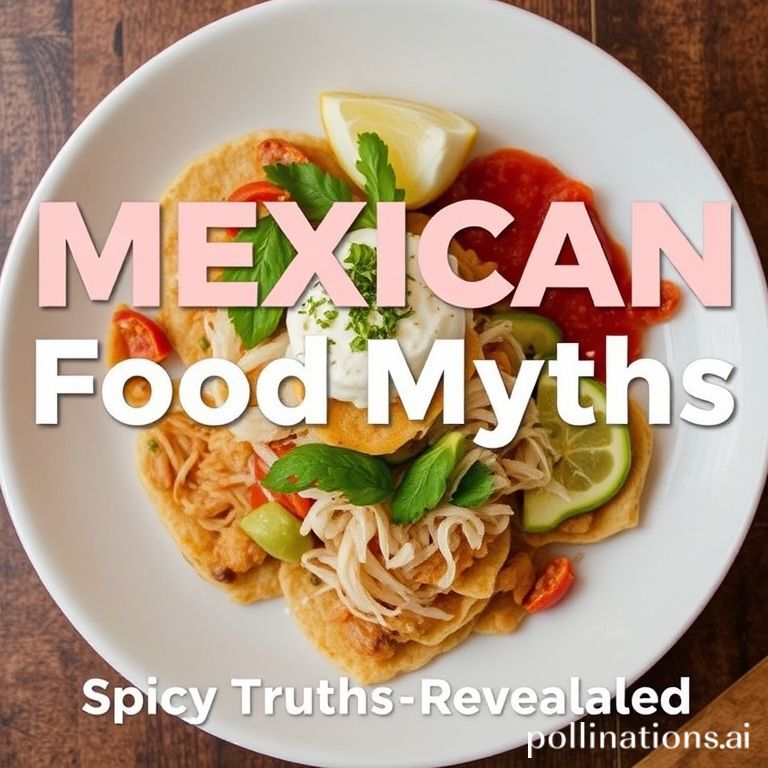Mexican cuisine is celebrated worldwide for its vibrant flavors, rich history, and diverse regional variations. However, it’s also often misunderstood, with many misconceptions clouding its true essence. One of the most pervasive myths is that all Mexican food is fiery hot. While chili peppers are indeed a staple ingredient, the reality is far more nuanced and delightful. Let’s debunk some common myths and uncover the delicious truths about Mexican food.
Understanding these myths is crucial not only for appreciating Mexican gastronomy but also for approaching it with an open mind and palate. From the subtle use of spices to the regional differences that define the cuisine, there’s a world of flavor waiting to be explored beyond the stereotypes.
Myth 1: All Mexican Food is Extremely Spicy
This is perhaps the most widespread and inaccurate belief. While certain dishes do pack a punch, Mexican cuisine is more about layering flavors and using spices thoughtfully. Chili peppers are used to add depth and complexity, not just heat. Many traditional dishes feature mild peppers like poblano or guajillo, which contribute smoky and fruity notes rather than intense spiciness.
The Role of Chili Peppers
- Chili peppers are diverse: From mild to scorching, the variety is astounding.
- They add flavor, not just heat: Used judiciously, they enhance the overall taste profile.
- Heat is adjustable: Many restaurants allow you to customize the spiciness level.
Myth 2: Mexican Food is Just Tacos and Burritos
While tacos and burritos are undeniably popular, they represent only a tiny fraction of Mexican culinary offerings. Mexico boasts a vast range of regional specialties, from the mole sauces of Oaxaca to the seafood dishes of the coastal regions. Each state has its unique culinary identity, shaped by local ingredients and traditions.
Exploring Regional Dishes
- Mole: A complex sauce with dozens of ingredients, each region has its unique version.
- Cochinita Pibil: Slow-roasted pork marinated in achiote, a Yucatan specialty.
- Pozole: A hearty stew made with hominy and meat, perfect for cooler weather.
Myth 3: Mexican Food is Unhealthy
This myth stems from the perception that Mexican food is heavy on cheese, fried ingredients, and processed foods. While some dishes may be indulgent, traditional Mexican cuisine emphasizes fresh, whole ingredients like beans, corn, vegetables, and lean proteins. Many dishes are naturally gluten-free and can be easily adapted to accommodate dietary restrictions.
Healthy Ingredients and Cooking Methods
- Beans: A staple source of protein and fiber.
- Corn: Used in tortillas, tamales, and other dishes, providing essential nutrients.
- Fresh Produce: Abundant in salads, salsas, and vegetable-based dishes.
Myth 4: All Mexican Restaurants are Authentic
The term “authentic” can be subjective, but not all Mexican restaurants offer a true representation of the cuisine. Many establishments cater to Western palates, simplifying flavors and using lower-quality ingredients. Look for restaurants that prioritize fresh, local ingredients and adhere to traditional cooking methods.
Tips for Finding Authentic Mexican Food
- Research: Read reviews and ask locals for recommendations.
- Look for regional specialties: Authentic restaurants often highlight dishes from specific regions.
- Trust your senses: The aroma, presentation, and taste should be indicative of quality ingredients and careful preparation.
Myth 5: Mexican Food is the Same Everywhere
As mentioned earlier, Mexican cuisine is incredibly diverse, with each region boasting its unique culinary traditions. What you find in northern Mexico will be vastly different from what’s served in the Yucatan Peninsula. Understanding these regional variations is key to appreciating the richness and complexity of Mexican food.
Regional Culinary Highlights
- Northern Mexico: Known for its beef dishes and flour tortillas.
- Central Mexico: Offers a blend of indigenous and European influences.
- Yucatan Peninsula: Features unique flavors like achiote and habanero peppers.
Conclusion
By debunking these common myths, we can gain a deeper appreciation for the artistry and diversity of Mexican cuisine. It’s a world of vibrant flavors, fresh ingredients, and regional specialties waiting to be explored. So, the next time you encounter Mexican food, remember that there’s much more to it than just tacos and spice – it’s a culinary journey through a rich and fascinating culture.
Ready to explore the real tastes of Mexico? Share your favorite Mexican dish in the comments below!
IMAGE: A vibrant and colorful spread of diverse Mexican dishes, including mole, cochinita pibil, tamales, and various salsas. The scene is set in a rustic Mexican kitchen with warm, inviting lighting. The mood is celebratory and authentic, showcasing the richness and variety of Mexican cuisine. Focus on fresh ingredients and traditional serving ware. Style: Food photography with a touch of documentary realism.


